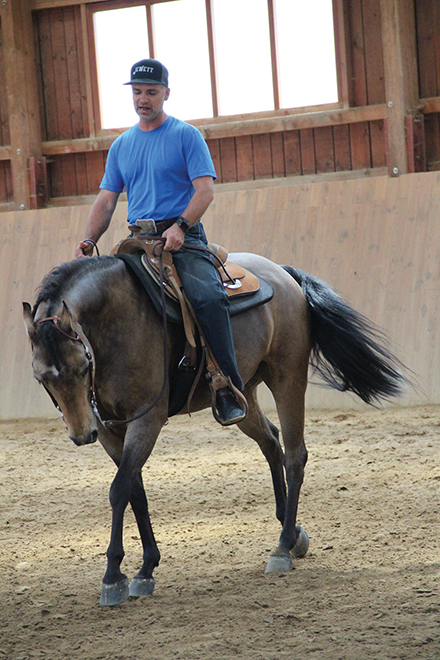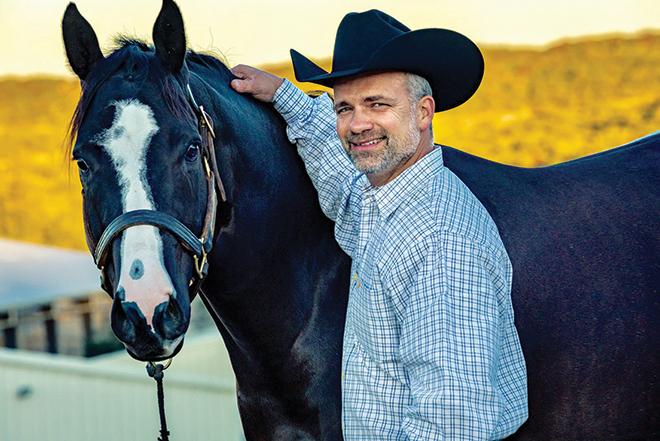Sometimes, no matter what the discipline, a show horse hits a brick wall in the training process and just fails to perform at the level expected.
There are many potential reasons for the change – stress, horse show burnout, a change in rider or discipline.
The first thing that needs to happen is that any existing underlying pain needs to be treated. Discomfort can and often does, leave a horse anticipating the pain that was there before, even when resolved, further causing performance issues.
But there are times, when pain is not the issue and it takes a savvy trainer to realize when it’s time to go back to square one.
Virginia professional trainer Steve Meadows has seen it before – in any number of events he has trained a horse to compete. In recent years his program has focused on the Ranch events.
“I train horses for the Ranch Versatility classes and we commonly seek out Ranching Heritage bred horses, but a lot of the horses we show come from the Reining/Cowhorse disciplines,” he explained. “Some of those horses have been finely tuned to make the maneuvers electric, or to focus on a cow. We take those horses back to the basics and turn them down so that they are more relaxed and are more willing to do the tasks required of a real working ranch horse.”
Many times trainers find that all of a sudden, they can’t seem to push a horse forward. That horse will draw back into the bridle and the result is a horse with too much lift.
“Behaviors that display this issue could be a horse that runs backwards when you draw your bridle/reins, a horse that won’t spin properly or one that may run through the bridle when you try to press them through with your leg,” said Texas professional Brad Jewett, who is experienced in training the Western Riding contender. “This is commonly caused from putting a horse’s head down, but not getting his withers up in the process. When a horse does not give in its withers or when I cannot draw my hand softly and press my horse to the bridle, that’s when I know I need to back to square one.”
As riders, we all have our strengths and weaknesses. Horses also have strengths and weaknesses, and sometimes when things start to get challenging, that’s when the weaknesses can turn into vices.
“Normally, depending upon what I’m met with, either I increase the difficulty level or revisit what has already been done,” explained Missouri professional trainer Jamie Dowdy. “If I increase the difficulty level, it’s because I feel the horse is bored and acting out. If I choose to regress and revisit something that has been addressed, it will most likely have to do with a mental and physical capacity issue, or something getting dangerous. These can be expressed in basic anxiety, tightness, throwing body pieces around, spooking, or aggressive behavior like bucking, rearing, etc. Normally, I start addressing my horse by flexing each way at the walk, just as you will do on a baby and work my way through each gear. Depending on where the fallout is, most likely, I will find it hidden from the horse’s poll back.”
Going Back to Square one
Once these trainers identified some of these roadblocks, it was time to take the horse back to the beginning. Sometimes, square one means truly going back to that foundational training in order to move forward.
“Each of us trainers have a different feel for what we want of course, but I can tell you all of my horses must be able to be handled. If they can’t do the basics of giving their body and face, then we need to create that foundation again – and that takes as long as it takes,” Jewett said.
Meadows has been in the same spot.
“A couple years ago, I bought a beautiful 4-year-old mare from a Reining trainer that did not make a Level 4 futurity horse,” he explained. “When I started riding her, she had a lot of anxiety in the arena. In other words, she didn’t like arenas, she didn’t like the bit in her mouth and she didn’t like people. I rode her for one month, and I was almost ready to give up on her. My wife was riding her one day, and I was watching her. I told my wife that we needed to try something different. So, the next day, I put a loping hackamore on her and went straight to the pasture to ride. For the next three weeks, I rode her in the pastures and woods in that loping hackamore, just riding straight with no pulling or training at all. One day, she took a deep breath, and started relaxing and letting me ask for her face. That was it! I gave her a job and she started accepting it. She went on to be an NSBA World Champion and Congress Reserve Champion.”
Dowdy said she finds it much easier to train a horse she has had from the start.
“I know my weak points and theirs,” she said. “However, taking a horse from another program, especially one that has been showing, means they most likely have developed muscle memory and are pretty steadfast in the ‘I’m doing it this way’ mentality,” she said.
She recently had that come up in her program.
“I had a horse that had previously shown but, in my opinion, had a head-neck position lower than its balance point and couldn’t utilize his full potential,” she explained. “I worked away for a handful of months, building his muscles, and showing him where to be. Finally, he had enough, got mad, and started throwing his head and neck in the air for months at different times. Sometimes, you have to go the other way before you can find your middle. We let him essentially flail until he found that middle on his own.”
For the Ranch horses, it’s very simple.
“We start using them like real Ranch horses outside the arena, Meadows explained. “We go back to a basic snaffle bit or hackamore. We go through gates, because there’s cowboy latches on all of my pasture gates that can be worked horseback. We push cattle or other horses on them. We may pony a young horse.”
Or they may just go trotting through the woods.
“They learn the Ranch maneuvers while performing a real job, so it gives them something to focus on besides me just riding them in a circle pulling on them,” he said.
Returning to the true basics of bridle work and getting the horse to move its body properly is many times the key to re-training at square one.
“I will do a lot of lateral work to the point where I can send them up to the bridle,” Jewett said. “I do a lot of turning, backing and then sending them forward to the bridle.”
To do the process properly, it does take a good 6-12 months.
“But you can teach the process in 60-120 days,” Jewett said. “Of course, there are exceptions to the rule – there are easier and more difficult horses. An easy barometer to tell if they’re turning around properly is if they’re not running from your leg, or past the bridle. Once the horse has learned the process, maintenance is usually easy unless you have a rider that is quick and heavy handed.”
Other trainers agree that it does take at least six months to see a significant change, and redirecting the horses’ thoughts over that period of time is the game changer.
“I think it takes six months to a year,” Dowdy said. “Each horse is different, though. Having clients that let you train and don’t say, ‘I need results now’ is going to be really helpful too. I think that there is a basic body composition and suppleness that most need to be accepting of. It’s not forced, but something they basically have practiced enough that they go and look for.”
Those that do one practice specifically will start to maybe get bored or lazy and lose physicality in areas.
“I primarily focus on Western Pleasure being my basic building block, and then hopefully lead into Western Riding,” Dowdy said. “Being physical at a slow rate and then increasing that to a higher rate and maintaining that physicality makes me feel like I’m creating a happy, whole mentally and physically capable horse.
Figuring out how to not fight, but instead, take that negative train of thought and redirect it without the result driven aspect is key.
“My goal is just to evolve slowly and positively,” she said.
Keeping things fresh and interesting for the horse is also important when going back to square one.
“We try to be creative in our daily routine.” Meadows said. “We change up where we ride and what we work on every day.”
That process takes more work and planning, but it’s crucial to the horse’s mental health.
“The timeline depends on the horse and their mentality, and we tell the owners not to expect to see a difference in the first few months,” Meadows said. “We seem to have a really dependable horse in a year. It’s very easy to tell on our horses when they are making progress – their mannerisms change quite a bit. The anxiety goes away, and they accept the training and other riders with no negativity. Just a relaxed, happy horse.”







You must be logged in to post a comment Login